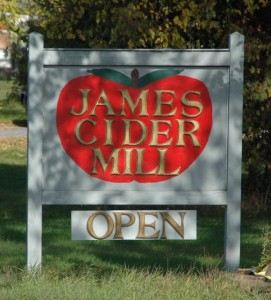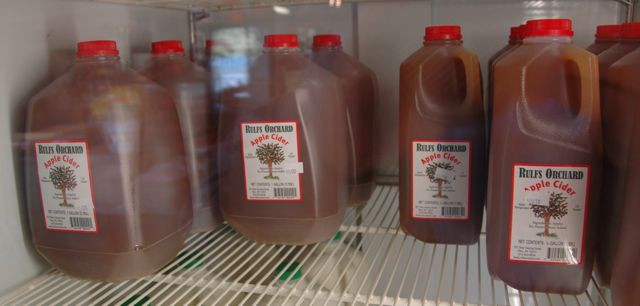Peru is a great place for cider lovers
At this time of year many people look forward to tasting Peru’s fresh apples and an apple-based product, apple cider. Rulfs Orchard and James Cider Mill produce thousands of gallons of cider for sale at their roadside stands and distribution throughout the north country.
While Patti Rulfs Sheehan is usually found in Rulfs’ bakery preparing delicious pies, she is also very knowledgeable about making cider. Patti explained that cider is made from so-called cider or utility apples that have flaws making them unmarketable as eating apples. (Click here to view cider-making) It takes about ten to twelve pounds of apples to make one gallon of cider.
The first step in the process is cleaning which is accomplished by passing the apples through a series of brushes immersed in water. A grinder then pulverizes the apples, seeds and skins included, into a mash that has a consistency resembling applesauce. The mash is piped to a stack of cheesecloth-covered wooden racks where hydraulic pressure pushes the mash against a wooden block thereby expelling the cider. The cider is then piped to a UV machine which removes any bacteria. Finally, it is pumped into large stainless steel tanks where it is held until the retail containers are ready to be filled. While most cider is sold at this time of year, Rulfs produces fresh cider from Labor Day to Memorial Day.
Apple cider differs from apple juice in that it is not pasteurized and has no preservatives. After two weeks carbonization begins and apple cider begins turning into “hard cider.”
 Emerson and Doreen James opened James Cider Mill in the late 1960’s. The James’ have dedicated almost all the apples on their nearby 300 to 400 apple trees to cider use. Emerson James says he blends several apple varieties to produce his unique product. He designed his own apple washing machine which he speaks about with considerable pride. The James Cider Mill is located at 2814 Main Street (Route 22) just outside the hamlet. Customers travel down a long driveway to reach the mill. James Cider can also be found at many other roadside stands including Northern Orchards on the Union Road in Peru and Everett’s and Pray’s in Plattsburgh.
Emerson and Doreen James opened James Cider Mill in the late 1960’s. The James’ have dedicated almost all the apples on their nearby 300 to 400 apple trees to cider use. Emerson James says he blends several apple varieties to produce his unique product. He designed his own apple washing machine which he speaks about with considerable pride. The James Cider Mill is located at 2814 Main Street (Route 22) just outside the hamlet. Customers travel down a long driveway to reach the mill. James Cider can also be found at many other roadside stands including Northern Orchards on the Union Road in Peru and Everett’s and Pray’s in Plattsburgh.
Posted: October 9th, 2010 under General News, Peru/Regional History, Things to do in & near Peru.

